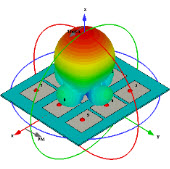土问:仿真软件2.5维和3维的有啥区别呢?
2.5d仿真软件介于2d和3d之间,可以在z轴方向上设置参数(例如对于
微带线,可以设置厚度,各层的介点常数等),但是在进行仿真运算是
是将平面电路划分为平面的单元各进行数值分析,这样使得计算速度
大大提高了,而对于3d仿真软件,顾名思义就是立体建模,并且在仿真
运算时是将模型划分为四面体,当然运算时间就大大增长了。
多谢了。
我还想知道2.5d的仿真软件在仿真一条微带线的时候它是如何考虑z轴上的各参数(如介质层厚度,Er。。。)对场分布的影响呢?
还有下面一段我看来的对ads的评价,不知你评价如何呢?
麻烦你了。:)
I would like to add my opinion on the topic. Considering what both products are intended for, they are both very good and serve to the same purpose of geting you close to desired performnace of your circuits.
However, I also think that @gilent is using a lot an old glory and the leader rating in measurment instrumentation to sell this product at unjustified price. This program is far from the best product that the company has ever created. The bizare and most obvious thing - try to redo something being undone. They just don't want to be bothered introducing this detail. You will always get the same answer from the support - there are some problems.
I have never ever seen any manual set like those for @DS. Each of the manuals is organized ad hock and cross referenced with 20 other manuals so you can read the whole day and don't get the answer to your question. Support can and will answer your question but why they need to supply manual at all. Examples are very trivial, if they issue a new software version some of the old examples will not work, I withnes this myself! They supply the tutorials, a litle less trivial and design guides that are reasonably good but come with a price.
Not the mention that for example, Momentum comes with 3 prices (and licenses!), basic simulator, current viewer and optimizer. You can analize your EM structure quite accurately, however, 3D view is available at the end of the simulation, in post processor. Very practical indeed!
Try to use transmisson lines discontinuities like bends and Ts with envelope or transient simulator. They say you can co-simulate. Yeah, you can invent something really new if you take your results for grant. Support will tell you to replace lines and discontinuites with lumped models!
I can elaborate on this much more. To cut long story, lets just say that @DS is realy a good program if you are sure that you are falling into two categories:
First is basic user with very limited requirements so you will never face any problem of running out of your nerves as there are some basic thing you can guess and guess it right! But, there might be much cheaper solutions for you apart form @DS.
Second group are really serious users that are making/supplying the customers with foundries, making a multidisclipinary simulation environment in a team of 50+ engineers etc. where there is a team of 3+ engineers that are customizing @DS for the particular need and engineers to a particular @DS secret thay are supposed to use. They are running a lot of licenses, thus paying serious money and @gilent will write user-specific patches to suite their needs.
MWO is slightly less versatile but intuitive to use, very well explained and much faster to run! And there are no major pitfails like in @DS. I run the same circuit (100%) in both nonliner simulators. @DS - 15 min, MWO 3 min! Results were very close to measurements in both cases.
And yes, Steve Mass is the Microwave guru and AWR doesn't need any other advertisment but his name!
为了答辩,准备这个问题,想起来这个帖子
以下是比较权威的回答,贴上来供大家参考
原来人家的问题是酱紫的
A simple but unclear (to me) question. What is the exact
definition of "2.5D problems" ?
回答一:
2.5D usually refers to method of moments (MoM) codes for planar circuits.
You can have multiple, homogeneous dielectric layers and metal patterns
at each dielectric interface. You can also have via metal between planar
metal layers.
To save time and complexity, most codes solve for the XY currents on the
planar conductors and use a different, simpler approximation for the Z
directed currents on the via metal. So vias can couple to each other, but they
don't couple to planar metal. One fallout from this is an analysis of shielding due to
a "fence" of vias may not be accurate. Or using via metal to build an
isolation wall in a package may not give the expected results.
Sonnet em, Emsite, Momentum, Ensemble fall into this camp.
The one commercial exception is IE3D from Zeland. They retain the full 3D
Green's function (or potential function) for the current distribution. So you can
place metal at arbitrary angles and there is no separate approximation for Z directed
currents. The down side may be a hit on solution time because the math is tougher.
sonnet 的权威是这样回应这封信的
Dan -- Noticed your comments. Just want to correct one misunderstanding,
Sonnet includes all coupling, via-to-via, via-to-X/Y, etc., to full
numerical (usually double) precision, leaving cell size as the only
significant approximation.
I worked quite hard on that one, wouldn't want people to get the wrong idea
that we are approximate when accuracy is our primary strength. Also, for the
open environment codes, I suspect that they might get pretty slow when there
are a large number of layers (say, 5-10), although I have no specific
knowledge there (I don't go around trying to do competitive benchmarks). I
have done circuits with over 1000 layers, and it is still primarily limited
by the matrix solve time.
As for 2.5-D, will tell you a story about that. As far as I know I
introduced the term back in 1984 when I was working on my dissertation. At
that time we did not have vias, just X-Y current. My friends back at GE (who
were funding my Ph. D.) looked at the current and called it a 2-D analysis.
Harrington looked at the fields and called it 3-D. To Harrington, 2-D meant
infinite lengths of waveguide, etc. Since my success depended on the good
will of both parties, and since I had just read a book on chaos theory (and
related fractal theory where fractional dimensionality is explicitly
defined), I compromised and called it a 2.5 - D analysis.
Shortly after that, I added vias and had full 3-D current and full 3-D
fields, just restricted to a planar dielectric. So I started, and continue,
to call it a 3-D planar analysis. However, I guess "2.5-D" sounds so cool,
it is often used equivalent to 3-D planar, even though it is hard to justify
quantitatively.
I wrote a short paper on this, discussing dimensionality and appropriate
quantitative justifications of all common types of EM analyses a while back,
(I think we had a short discussion about it, but that was a while ago, gosh
time flies!) will send you (and anyone else who wants it) a copy if desired:
J. C. Rautio, "Some Comments on Electromagnetic Dimensionality", IEEE MTT-S
Newsletter, Winter 1992, pg. 23.
As far as I know, no one else in microwaves was using the term 2.5-D before
I pulled it out of fractal theory.
As for vias not doing well when making a wall, that is because their design
in Sonnet (and most other planar codes) is not intended for that purpose.
Specifically, Sonnet uses vias which are rectangular cylinders with uniform
current along their length flowing through the entire volume. They work very
well when transferring current from one layer to another (their intended
purpose), but not nearly as well for making conducting walls. It is entirely
possible to design vias that would work well for making walls. (Actually, it
would require two kinds of vias, the first transfers current vertically, the
second horizontally, and you have two possible horizontal directions further
complicating matters, and it would have to be sheet current, not volume
current, and a linear change in magnitude and phase along the subsection
length would be required.) Entirely possible, with no new theory required at
all, but I realized early on that if you are going to get into that kind of
complication, you would get into big-time slow-downs for large circuits. So,
I left that problem to the 3-D volume meshing codes, which they handle very
well.
Dr. James C. Rautio
相关文章:
- 电磁场仿真优化软件包--IE3D(05-08)
- 电磁场仿真软件包&--FIDELITY(05-08)
- 请大侠推荐一个FDTD仿真方面的软件????(05-08)
- 请问目前主要有哪些FDTD的仿真计算软件?(05-08)
- 请问:有没有基于物理光学法的天线仿真软件?(05-08)
- 如果想仿真贴片天线上的电流分布,用什么软件?(05-08)











